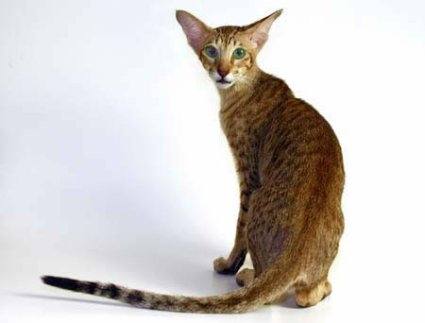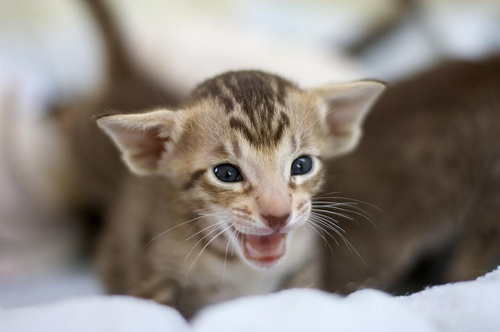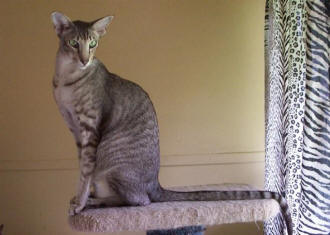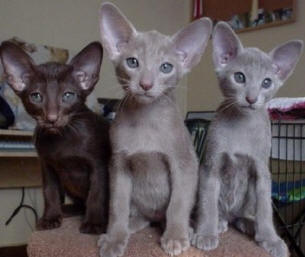



|
Oriental Description
The Oriental resembles the Siamese in shape only. With more than 300 color and pattern options, the breed provides a owners a staggering number of choices: solid, smoke, shaded, parti-color, tabby in the four classical patterns, patched tabby, bi-color and recently a long-haired Oriental embodying all these as well, in every color possessed by cats.
In keeping with the traditions set down by the Siamese standard, Orientals are a lithe cat, long and lean. Though they appear slim, however, do not be fooled. The cat is quite muscular and not fragile. The head of the Oriental is wedge-shaped and in good proportion to the body. The body should be long and lithe, a precise combination of fine bones and good musculature. Hips should not be wider than the shoulders; with long slim legs ending in small, dainty and oval-shaped feet.
The coat of the Oriental, whether long or short, should lay close to the body and be silky. Eye color should be green, blue, or cross-eyed with even depth depending on the shade of coat.
Oriental Temperament
The Oriental is a very loving and devoted animal. They will often pick one member of the family as their own and devote themselves fully to that single individual. Prone to depression when ignored, the Oriental will seek your approval and love constantly with gentle nudges, stealing of your lap, and loud purrs.
They are equally as vocal as the Siamese, if not more so. Their soft and mild tone will greet you at the door as they tell you all about their day and question you about yours. Orientals are incredibly intelligent. Simply hiding a toy will not deter one; they will open drawers and doors or pull everything out of a bag looking for what they want. It is best to try and train an Oriental by making training into play time. This appeases both their need for attention and their curiosity while preserving your sanity.
Oriental Care
Regular brushing is necessary for both the long and short haired breeds as it helps to control hairballs. Health concerns for the Oriental are few but similar to those of the Siamese from which they are derived; protrusion of the sternum, and Endocardial fibroelastosis are two such concerns, and when purchasing from a breeder it is wise to gather the medical history of your kitten and have it examined by an animal health professional.
Oriental History
The history of the Oriental is rather short as the breed has not been around long. It is directly related to the Siamese and shares that portion of the heritage in the Royal Palace of Siam. Orientals were first developed in the 1950's and 60's by breeders who had received requests for a cat that looked like a Siamese in body but came in different colors. Breeders took their Siamese and outbred them to Domestic Shorthairs, Russian Blues, Abyssinians, and back to Siamese to get the diversity in color but preserve the endearing and loving personality.
The CFA officially recognized the short-haired Oriental in 1972, granting it Championship status in 1977. The long haired version achieved recognition in 1988 after being bred with the long-haired Balinese. In 1996 both versions were combined into one division, what we know as the Oriental.
|